

 |
June 3, 2017: A Walking Tour of the Old City of Istanbul |
 |
Return to the Index for Our Visit to Istanbul |
Today, Fred and I will be returning to the United States after our two weeks here in Europe. It's been fun, but it will be nice to get home. In addition to our actual return trip, this page will also feature our pictures of the Nippon Hotel where we stayed. It will also contain pictures relating to one of Istanbul's nicer oddities- its cats.
The Nippon Hotel
We didn't take that many pictures around the Nippon Hotel; it was more like the Ibis Hotel in Prague (simple, inexpensive rooms) than it was like the Hotel Am Steinplatz in Berlin (a boutique hotel with fashionable rooms and more opulent public spaces).
|
| "Nippon Hotel is nearly the first Hotel in Talimhane since 1989. After 16 years experience we knew that we should do something exclusive. We closed the Hotel in November 2005 and had a long renovation. Nippon Hotel opened its doors on 14th June 2006 with new structuring and new professional team. Our mission is to increase your aim with our Turkish tradition of hospitalty and keep our standarts very high which so that everybody leaves us happy." |
While perhaps not grammatically accurate (hey, I only know a couple of words in Turkish), it was pretty much true; the hotel seemed very new, with the rooms (at least the one we had) bright and clean and with all the amenities one really needs.
The lobby was fairly small but very functional, and the staff were very, very helpful when we asked questions about what to see and how to get around. They even gave each of us a starter transit card with a couple of bucks loaded on it so that we would not have to buy our own. (The card itself costs money, separate from the amount you might load onto it to pay for actual travel. We turned these cards back in to the desk when we departed, and I imagine they load another few dollars onto them to give to the next guest who might need one.)
I did wander about the public areas, and discovered a nice gym (although we had no time to take advantage of it), a simple but classy restaurant and bar, and more extensive meeting rooms than I might have expected in a small hotel. And no, I didn't see any Oriental staff at all.
|
We actually had a room with a single queen-sized bed, but other than that, the room was very similar to the picture that you see here. The ensuite bath is out of the picture to the right. We were on the 7th floor, and had a decent view to the east. The only other pictures we took inside the hotel were a couple in the lobby:
 (Click on Thumbnails to View) |
The Nippon Hotel turned out to be very well-located, although I did investigate location when I was looking at hotels online before our trip.
|
Everything was convenient- including public transit and, as we found out on our last day, the stop for the bus to the airport. There was even a nearby shop for folks in the market for a mannequin!
The last picture we took was of the street outside the hotel; the view looks south towards Taksim Square.
Taksim Gezi Park
Taksim Gezi Park is an urban park adjacent to and just north of Taksim Square. It is one of the last green spaces in this area of Istanbul, and is also one of the city's smallest parks of Istanbul. On the morning of our departure, I was up early so I left Fred at the hotel and walked up to the park for a look around.
|
In 1936, a French architect and city planner was invited to Turkey by President Mustafa Kemal Atatürk. He was tasked with the preparation of Istanbul's rough-cut urban planning and rebuilding, which lasted until 1951. One of his creations was Taksim Square, where the earlier barracks had been located. In his master plan for the city, which was adopted by Istanbul in 1939, he provided for a much larger, 74-acre Taksim Gezi Park with continuous green space extending all the way to the Bosphorus. This larger park was intended to offer green space for recreation to Istanbul's residents and tourists, but it has never been completely realized.
The construction of today's Taksim Gezi Park was completed in 1943. The park's area diminished in later years with the construction of big hotels in the outlying zone. Nevertheless, the park remained an important recreational area within the downtown of the city, and its appearance changed for the better after restoration.
I walked through the neighborhood around the Nippon Hotel towards the park (actually only a couple of blocks away). I eventually crossed over into Taksim Square with the park ahead of me. Then, when I was about to enter the park, I stopped to take a panoramic view of the new buildings that now line the square:

Then I crossed into the park itself. From this part of the square, there is a broad flight of stairs up into the park, and these stairs bring you right to the centerpiece of the park- its main fountain.
|
In late May 2013 protests began to occur against plans to replace Taksim Gezi Park with a shopping mall and possible residences. The protests developed into riots when a group began occupying Taksim square and the police tried to suppress the demonstrations.
The subjects of the protests broadened beyond the development of Taksim Gezi Park, covering issues such as freedom of assembly and freedom of expression, as well as more broadly defending the secularism of Turkey. The protests also spread to other cities in Turkey, and protests were seen in other countries with significant Turkish communities.
On 31 May 2013, police suppressed the protesters with tear gas and pressurized water, actions that received wide attention online. Following these protests, the Istanbul-based platform InEnArt presented "Urban Voices" which opened a critical view on cultural practices and phenomena that express the ethos, aspirations, and dreams of a specific population during a well-defined era. One section of this online presentation focused on the protest culture in Turkey and its development during that year.
Now, four years later, things are quieter. Sadly, eight people lost their lives in those protests in 2013, including one police officer who fell from a bridge while chasing demonstrators. Over 8,000 people were injured. The protests became less about the park, whose existence was eventually confirmed, and more about freedom from authoritarianism- an infection to which many people think Turkey is beginning to succumb. This was why we were anticipating much more of a police presence than we found during our days here. One might hope that the Turkish government would adjust its point of view in response to the continuing protests; we shall see.
I have to more pictures to include here. I was using my tablet this morning, instead of my camera, so to create panoramic views I had to take individual pictures and put them together in post-production. First, here is the fountain:

Finally, I was able to put six photos together to create an almost-360° panorama of the park (looking towards Taksim Square):

The Cats of Istanbul
“Without the cat, Istanbul would lose a part of its soul,” explains one resident in “Kedi” (“Cat”), a charming new documentary. In Turkey’s sprawling cultural capital, cats are a feisty symbol of the city’s 16 million strivers. Hundreds of thousands of strays, neither feral nor tame, live among the denizens of Istanbul. The animals are as comfortable lounging with tea drinkers at a café as they are dodging cars on traffic-choked streets.
|
You should definitely find a way to watch this movie, especially if you are a "cat person". I have downloaded the trailer from YouTube, and you can use the movie player at left to watch it.
Istanbulites often place bowls of food and water on the sidewalk in a communal effort that lets cats roam free. The money in the tip box at one restaurant goes toward the veterinary bill for sick or injured animals; at a fisherman’s stand, cats get to sample the tiny anchovies plucked from the Bosporus. People often feel duty-bound to care for the animals that hang around their home or workplace, despite the cool nonchalance of the cats themselves. “Cats know that people act as middlemen to God’s will,” says one Istanbul resident in the film. “They’re not ungrateful—they just know better.”
“Kedi” premiered at the 2016 "!f" Istanbul Independent Film Festival and opened in New York 1n February, expanding to other cities thereafter. Director Ceyda Torun, who lived in Istanbul until she was 11, examines life in the metropolis from the perspective of seven plucky felines with names like “Hustler” and “Psycho”. Their antics elicit musings from their quasi-owners on life, love and God. Ms Torun’s camera alternately glides knee-high alongside sauntering cats and then swoops over rooftops for stunning aerial views of the Golden Horn.
|
(If you doubt the cats-and-mosques connection, simply recall the picture from yesterday inside the Hagia Sophia where you can see a couple of cats lounging at the base of the large minbar.)
Turkey is not unique among predominately Muslim countries for honouring its cats, which are considered ritually clean animals in Islam. In the hadith, the collected sayings and actions of Muhammad, there are numerous examples of the Prophet’s fondness for cats. By one account, Muhammad cut off his sleeve when he had to rise for prayers so as to not disturb a feline that had curled up on his robe for a nap.
In another tale, the pet cat of Abu Hurayrah (literally “father of the kitten”) saved Muhammad from an attack by a deadly serpent. Muhammad purportedly blessed the cat in gratitude, giving cats the ability to always land on their feet. Cats were considered guardians in other respects for the Islamic world: they defended libraries from destruction by mice and may have helped protect city populations from rat-borne plagues.
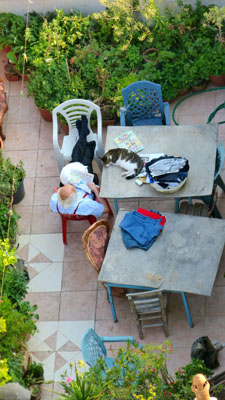 Looking Down from Galata Tower |
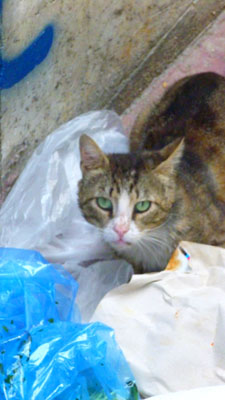 Near the Blue Mosque |
Anatolia is also home to the Angora and Van breeds, striking white cats that often have Heterochromia iridium, or different coloured irises. Van cats have an unusual fondness for water, making them well-suited for their home near Turkey’s largest lake. According to legend, a pair was on board Noah’s Ark; when the ship landed atop Mount Ararat, the cats jumped off and swam to shore.
The cats seemed to be everywhere; we met one- a very friendly black and white- as we were walking up the street from Gulhane Park to the Topkapi Palace. I don't think that more than a few minutes went by (when we were outside) that we didn't see one someplace or another.
Cats are not immune to the political rows in Turkey’s polarised society, however. In 2014, the Turkish energy minister blamed blackouts during the municipal elections on a rogue cat that he claimed entered a power station. The bizarre episode prompted sardonic jokes among government opponents, who cried foul play.
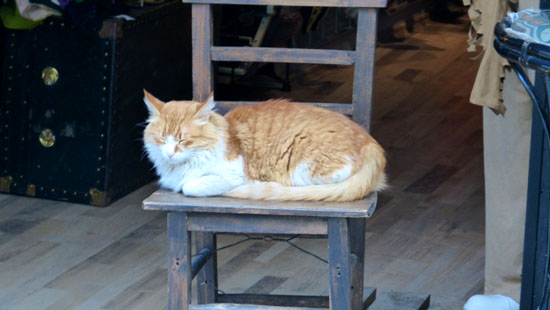 |
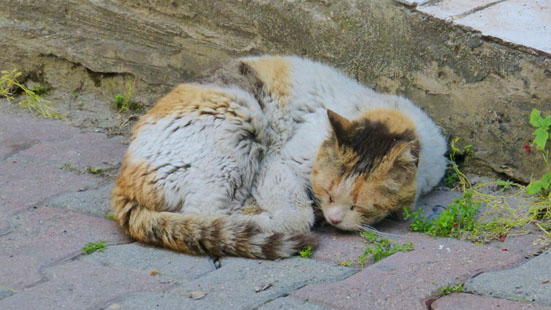 |
Despite the many heartwarming scenes in “Kedi”, the film also reflects what can be a harsh existence for these cats. One interviewee says that Istanbul’s human population is grappling with the same challenges that vex cats: a swelling population and breakneck urban development have transformed the city in recent years. Although thousands of economic migrants from the Anatolian countryside, massive infrastructure projects and political divides are reshaping the metropolis, the hardy strays are a constant. Like the city on two continents, the cats exist between worlds—domesticated and wild—but emerge with a character all their own.
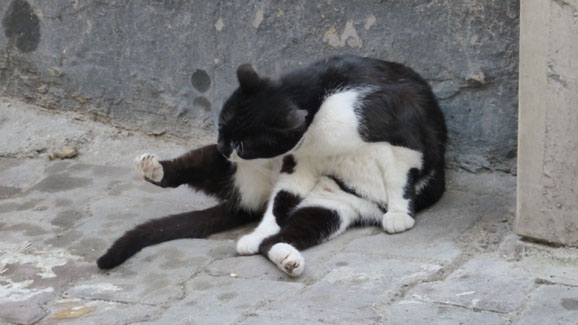 Gotta Stay Presentable |
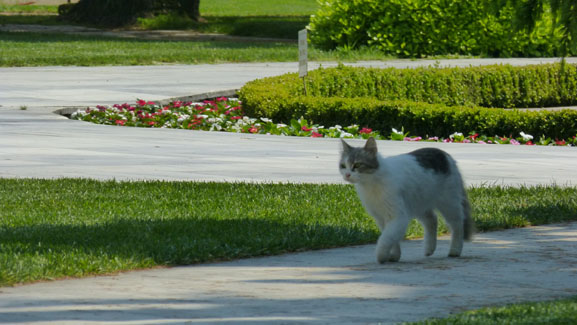 Out and About at Topkapi |
Our Return Trip to the USA
We left the Nippon Hotel about ten in the morning ahead of a 1PM flight from Ataturk Airport back to Miami. By now, we knew the ropes; the best and cheapest way to get to the airport was on the airport bus, and one attraction of the Nippon Hotel is that the bus stop is only one block away. So we hopped on the 10AM bus and were on our way home.
|
|
We took quite a few pictures along the ride, and I've selected a representative group of them. Look for interesting architecture (like this view of the airport Hilton Hotel), and you'll see the amazing building program going on in and around Istanbul. Look for pictures of the ruined walls that run all the way through the city and typical street scenes. And you'll see more of the amazing highway decoration as we enter the airport.
These pictures that we took are in the slideshow at left. As usual, you can move through the show by using the little arrows in the lower corners of each picture, and you can track your progress with the index numbers in the upper left of each one.
The ride to the airport was pleasant and quick; if we ever return to Istanbul, we will now know where to stay (the Nippon Hotel we thought was a bargain at about $55/night) and how to get back and forth to the airport ($8/person on the bus, instead of $30 in a taxi). The airport experience itself was also a good one. The bus let us off right at the Turkish Airlines terminal, and the signs leading us to our check-in desk were clear and easy to follow. At check-in, there was again a representative of the airline who asked our destination and directed us to bag drop-off, check-in, and security. This airport was busier than Prague, so security took a bit longer, but it was still on ten minutes or so.
We found our gate with little problem (but after quite a walk). That's when we ran into the only hiccup. We had known ahead of time about the Trump-induced "laptop ban" for flights coming from certain countries- including Turkey. That's why I didn't bring mine along on this trip but left it in Florida. I did bring the tablet, but put that in my checked luggage. We never heard anything about cameras, though, and when Fred got to the gate desk he was informed that he would have to check his.
|
Traveler after traveler was told to simply meet the airline agent in baggage claim in Miami where the trunks (and I think there were three full ones) would be available. All they would have to do is present their receipt and they would be given the device with the matching number. So far so good.
We boarded the plane and had a pleasant, if boring, 11-hour flight back to Miami. We both spent the time either eating one of the three meals that were served, or watching one of the 250+ movies available on the entertainment system in front of us. (I, myself, watched five movies, although I fast-forwarded through parts of two of them.) At one point I got up to take the picture at right.
When we got to baggage claim in Miami (and I must say that customs there was not nearly as bad as I thought it might have been), we should have taken the hint of some other travelers who immediately got in the electronics line. We thought we should get our bags first, which we did, so by the time Fred got in the line, there were fifty or so people in front of him. That's when the wisdom of getting in line early became apparent- and the fallacy in Turkish Airlines' receipt procedure did too.
I watched the process while Fred waited in the slow-moving line. I discovered that the first digit of the receipt number indicated which trunk the item was in, but even so, each trunk contained thirty or more items- all of which looked similar since everything was in the same bubble wrap. So at least for the first twenty or thirty people in line, the process of comparing the receipt number to each and every item (even just in a single trunk) took a long time- at least 2 minutes. That time slowly decreased as the number ot items in each trunk went down, but even with three agents working, it didn't go down very fast. Add to that the fact that some people wanted to immediately unwrap their item and ensure that it still worked before leaving the line, and you had an unholy mess.
It took Fred, about fifty people back in the line, almost an hour to finally get his camera.
But get it he finally did, and we headed off to the now-familiar rental car center to pick up our car and drive up to the Fort Lauderdale condo.
All in all, the trip to Europe was really great. I would do it again- particularly now that I am more familiar with Berlin, Prague, and Istanbul- and with Turkish Airlines and their procedures. They were the lowest cost by far to get back and forth, and their service equal to anybody's. But we were happy to be home with a chance to decompress for a few days in Fort Lauderdale.
You can use the links below to continue to another photo album page.
 |
June 3, 2017: A Walking Tour of the Old City of Istanbul |
 |
Return to the Index for Our Visit to Istanbul |